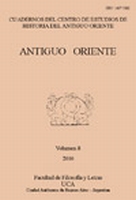Por favor, use este identificador para citar o enlazar este ítem:
https://repositorio.uca.edu.ar/handle/123456789/6756| Título: | La conexión árabe : una hipótesis sobre el surgimiento sociopolítico de Israel en Palestina The Arabian Connection: A Hypothesis on the Socio-Political Emergence of Israel in Palestine |
Autor: | Pfoh, Emanuel | Palabras clave: | HISTORIA POLITICA; HISTORIA SOCIAL; ETNICIDAD; ARQUEOLOGIA | Fecha de publicación: | 2010 | Editorial: | Pontificia Universidad Católica Argentina. Facultad de Filosofía y Letras. Departamento de Historia. Centro de Estudios de Historia del Antiguo Oriente | Cita: | Pfoh, E. La conexión árabe : una hipótesis sobre el surgimiento sociopolítico de Israel en Palestina” [en línea]. Antiguo Oriente: Cuadernos del Centro de Estudios de Historia del Antiguo Oriente. 2010, 8 Disponible en: https://repositorio.uca.edu.ar/handle/123456789/6756 | Resumen: | Abstract: Recent scholarship has shown that there is no solid archaeological or epigraphic evidence to deem the narratives about the rise to kingship of David and his son Solomon as reflecting the rise and consolidation of Israel as a Nation-State during the 10th century BCE. It is rather during the 9th century in the Palestinian highlands that we can find the emergence of a socio-political entity named Bīt Humri/ya or Israel in the contemporary archaeological and epigraphic records, but with an ambiguous character as a state. In this paper, it is suggested the possibility that the rise of such a polity and the constitution of an ethnogenesis are notably and directly related to the appearance of the Arabian network of exchanges in the early first millennium BCE in the Near East. Furthermore, from a critical point of view, one may suggest that there is no direct ethnic connection between the kingdoms of Israel and Judah and the later Jewish cults of Yahweh in Palestine. Resumen: Recientes estudios han demostrado que la historicidad de las narrativas del acceso al trono de David y de su hijo Salomón, como reflejo fidedigno del surgimiento y consolidación de Israel como un Estado-Nación hacia el siglo X a.C., no puede ser confirmada en el registro arqueológico o en el epigráfico. Así pues, es realmente durante el siglo IX a.C. en las tierras altas de Palestina que podemos detectar el surgimiento de una entidad sociopolítica mayor conocida como Bīt Humri/ya o Israel, de acuerdo con los registros arqueológico y epigráfico contemporáneos, pero de un carácter estatal ciertamente ambiguo. En este artículo sostenemos la posibilidad de que la aparición de esta entidad así como la constitución de una etnogénesis estén relacionadas, de manera notable y directa, con la aparición del comercio árabe en el Cercano Oriente a principios del primer milenio a.C. Más aún, desde un punto de vista crítico, se puede postular que no existe una conexión directa, en términos de etnicidad, entre los reinos de Israel y Judá de la Edad del Hierro y los posteriores cultos judíos a Yahweh en la Palestina helenístico-romana. |
Cobertura Espacial: | PALESTINA ISRAEL |
URI: | https://repositorio.uca.edu.ar/handle/123456789/6756 | ISSN: | 1667-9202 | Disciplina: | ARQUEOLOGIA | Derechos: | Acceso Abierto | Fuente: | Antiguo Oriente: Cuadernos del Centro de Estudios de Historia del Antiguo Oriente. 2010, 8 |
| Aparece en las colecciones: | AO - 2010 vol. 8 |
Ficheros en este ítem:
| Fichero | Descripción | Tamaño | Formato | |
|---|---|---|---|---|
| conexion-arabe-hipotesis-surgimiento-sociopolitico.pdf | 219,12 kB | Adobe PDF |  Visualizar/Abrir |
Visualizaciones de página(s)
658
comprobado en 30-abr-2024
Descarga(s)
296
comprobado en 30-abr-2024
Google ScholarTM
Ver en Google Scholar
Este ítem está sujeto a una Licencia Creative Commons

